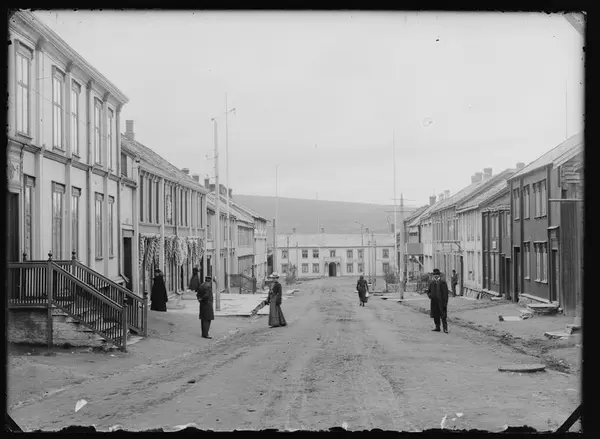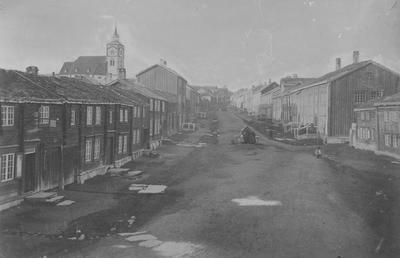- 1/1
Bergmannsgata 1900-1905 Iv. Olsen
Randi Borgos and Amund Spangen
Mining activity on the mountain slopes of Røros started around the middle of the 1600s., the first mine was at Storvola, later the northern mines of Nordgruvene were opened up. Both of the main mines are situated about 10 km away from the town. The waterfall (Fossen) on Hitterelva (the Hitter River) was the deciding factor for the placement of the smelting house and thereby where Røros would be built up. The people who arrived at the new workings were allowed to select a plot of land to build a house and still have enough space for animals and the buildings required to house them. These properties were built very close to each other in what came to set the special style of Røros. The majority of these people came from tiny smallholding in Trøndelag.
The first smelting house in Røros was working in 1646. The oldest map that we know of is from 1658. It would seem that the whole planning of the town was done on the drawing board. The map shows two main streets running parallel joined by linking, smaller lanes. The centre of town to this day has the same structure. It is possible that the shape of the land along the river decided how the town had to be built. Climatic conditions also played a part in the planning of the town. There was much more shelter to be found in building the houses close together affording some protection from the winter frosts and bad weather. It was also perhaps easier for the Røros Copper Works to keep control of what was going on when the people and the farms were tightly packed together.
The top management were well informed of new international arrivals. The town's roads are of the same pattern as the towns that were built during the renaissance. The town was burnt to the ground by Swedish troops in 1678 and again in 1679. At that time the building style in Europe was Baroque. The mining town was built up again after the fires, and on a town map from 1711 Storgata is shown to be broad at the lower end and slightly narrower up towards Morkstubakken. This effect, Baroque?s "false perspective", creates the impression of greater depth so that the street appears to be long, wide and spacious.
-
Bergmannsgata på Røros ca. 1865 Elen Schomragh
Along the eastern side of Storgata several of the Company's executives built their houses and farms. At the bottom end the street is closed off by the General Manager?s house, larger and more impressive than its neighbours, which were much lower and smaller buildings, modestly equipped. In keeping with the Baroque style of symmetry the General Manager's house was built out in the middle. The direction of the roof ridges of the ark are built at right angles to the main body of the house and point the direction of the gateway entrance. As on the Continent the whole was designed to show respect for the General Manager and the other executives of the works.
In Kjerkgata there were not so many "important" houses. Labourers' houses were built on both sides of a fairly evenly spaced street. At the top of the street was the old church, which dominated the scene. The old church was pulled down some time after the new church was completed in 1784. A new road was created by the elongation of Kjerkgata, which was laid over the old cemetery and joined the farms and houses at Haugan with the centre of the town.
Haugan is one of the three town districts that grew from the centre and the two main streets between 1600 and 1700. In the development of these three districts, following straight lines has not been a consideration. They have been built in a more haphazard manner. During the 1800s the town developed further along the approach roads. From the middle of the century small single room cottages were built, many without outhouses, along the old King?s Road to Trondheim, in Sleggveien and at Bakkan.
Holding down two jobs, as an employee of the Company, and as a smallholder, has been typical for the people of Røros right up to the 1960s. The workers had to run smallholdings to supplement their earnings and to achieve a reasonable standard of living. The neighbouring farms produced only enough for their own use and it was a long way to Trondheim. The Company's owners, the "participants" were obliged to make available provisions to the mining community, but different conditions such as, bad years to transport problems could create difficulties. Therefore the people had to produce as much food as they could themselves. This applied to everyone who settled here, from the General Manager, the executives, the clerks, officials, tradesmen, craftsmen and those who worked in the smelting house and the mines kept animals. Only a few of the inhabitants, mainly those who were in service in the houses, lived without smallholdings.
Animal husbandry was also a safety guarantee for the Company. In bad years the workers would at least have something to live off. The fact that the people owned their own houses and smallholdings meant that they were tied to the place and to their lands and they stayed on even in bad periods. It was a good way of ensuring there was a permanent labour force available. In addition, farming activities required the use of oxen and horses and these in turn were vital to the transportation activities of the mining industry.
Literature: This article is to a large extent reproduced from the book "Pa Sta'a og uti markom", 1st Edition, Randi Borgos and Amund Spangen, 2001
This is a part of:


